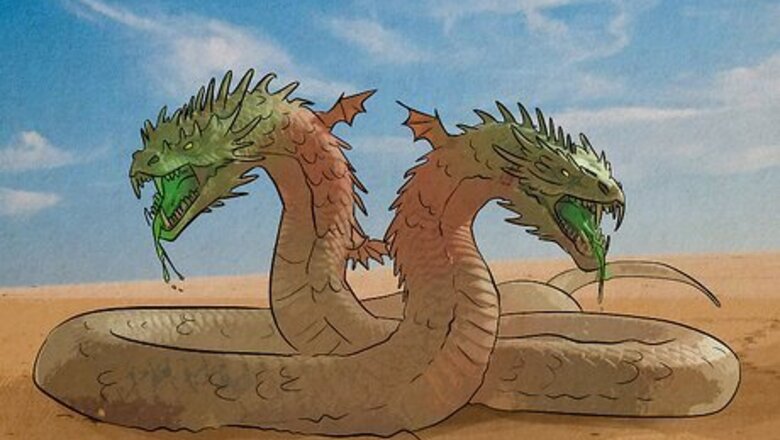
views
Creatures and Monsters in Greek Mythology
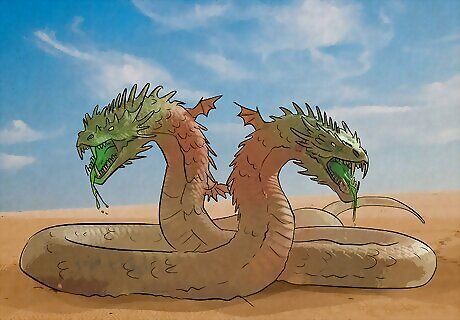
Amphisbaena The amphisbaena is a venomous ant-eating serpent with heads on either end of its body. Descriptions also mention glowing eyes and, in some cases, more dragon-like features (such as wings and small, rounded ears). In Greek myth, the amphisbaena was spawned from the blood dripping from Medusa’s severed head when the hero Perseus flew over the Libyan Desert carrying it.
Arae Arae are ghostly—or possibly demonic—female spirits created from curses. In Greek mythology, these grim creatures could result from a curse placed on the deceased by the person or persons guilty of their death. Associated with the underworld, arae were said to curse men (in a similar manner to the sun god Helios’s cattle, if harmed). Arae may also be related to or another version of the Erinyes, which are Greek chthonic goddesses of vengeance.
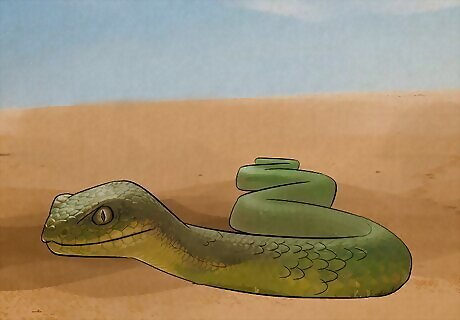
Basilisk You may have heard the term “basilisk” through works of fiction like Harry Potter—although the original version is a bit different, according to Roman author Pliny the Elder’s Naturalis Historia. The basilisk is a monstrous snake with venom so powerful that it leaves a wide trail wherever it goes, and is also capable of killing with its gaze alone. However, the basilisk isn’t any bigger than a real snake—only about “twelve inches in length.” According to the Naturalis Historia, the basilisk’s one major weakness is the odor of a weasel (strange as that might sound). The concept of a basilisk may have been inspired by certain venomous African and Asian snakes, such as the cobra.
Centaur Centaurs are creatures in Greek mythology with the upper body of a human and the lower body (including legs) of a horse. Greek myth describes them as wild, untamed horses, possibly named after Centaurus, a son of Apollo and father of the centaur race. However, other myths make centaurs the children of Ixion (king of the Lapiths) and Nephele (a goddess of clouds and rain). Centaurs of legend include: Agrius - A centaur who fought with the legendary hero Heracles. Asbolus - A centaur augur who could read omens in the flight of birds. Chiron - A healer raised by his foster father, Apollo, known as the “wisest and justest of all the centaurs.” Eurytus - A centaur who tried to kidnap Hippodamia at her wedding to Pirithous. Nessus - A centaur killed by the Greek hero Heracles, though Nessus’ blood then, in turn, killed Heracles. Pholus - A wise centaur said to be a friend of the hero Heracles.
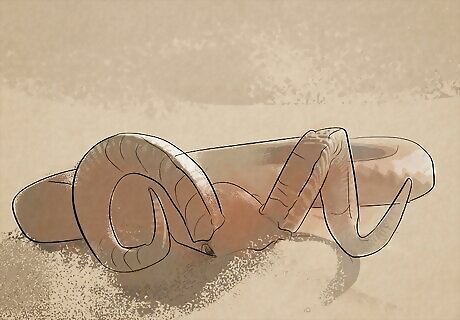
Cerastes The cerastes is a mythical Greek serpent said to have no spine, as well as two horns (resembling those of a ram) on its head, or two pairs of smaller horns. According to legend, the cerastes would hide its head in the sand, leaving only its horns visible, thereby fooling other animals into believing it was food. Then, when the animal came near, the cerastes would strike. The cerastes might be inspired by the desert-dwelling Saharan horned viper (whose scientific name is actually cerastes cerastes).
Cerberus Cerberus is the legendary hound of Hades, guardian of the gates to the underworld. Typically described as a three-headed dog with a serpent for a tail (and, even stranger, snakes sprouting from his body), Cerberus was responsible for preventing the dead from leaving the underworld. As the last of Heracles’ twelve labors, legend says the hero captured Cerberus and brought him back to Eurystheus of Mycenae.
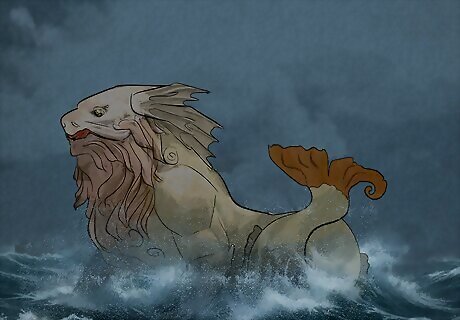
Cetus Cetus is a legendary Greek sea monster, described as an enormous, serpentine fish-like creature. Sometimes, the Cetus is also depicted with the head of a wild boar or greyhound and the body of a whale! In the myth of Perseus, Queen Cassiopeia and King Cepheus attempt to sacrifice their daughter, Andromeda, to the Cetus (in an attempt to appease Poseidon), and Perseus slays the monster to save her.
Charybdis Charybdis is yet another sea monster—one that appears in the legend of Odysseus (alongside Scylla) as a challenge he must overcome. Charybdis was said to live under a rock to one side of a narrow channel, the Strait of Messina. Three times a day, Charybdis would swallow a huge gulp of water and spit it back out, creating whirlpools that could sink ships. Scylla, another sea monster, lived on the opposite side of the strait; thus, sailors navigating it (like Odysseus) had to choose whether to sail closer to Scylla or Charybdis. The expression “between Scylla and Charybdis” is very similar to “between a rock and a hard place,” referring to being caught between two dangers and trying to avoid both.
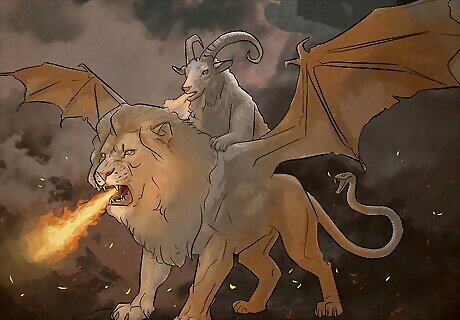
Chimera The chimera is a fire-breathing monster in Greek mythology, described as a hybrid made up of different animal parts. It’s usually depicted as a lion with a goat’s head sticking out of its back and a tail that ends in a snake’s head, though the chimera sometimes has dragon wings as well. Over time, the word “chimera” has grown to encompass any hybrid creature comprised of various animals. In Greek mythology, the chimera is a child of Typhon (a serpentine giant) and Echidna (a monstrous snake-woman), and the sibling of Cerberus, as well as the Lernaean Hydra.
Crocotta The crocotta is a mythical lion-hyena hybrid creature said to live in India or Aethiopia, able to mimic the voices of “men and cattle,” according to Pliny the Elder in his Naturalis Historia. Pliny went on to describe the crocotta as having an “unbroken ridge of bone in each jaw, forming a continuous tooth without any gum.” The scientific name of the spotted hyena is actually Crocuta crocuta, taken from the myth of the crocotta.
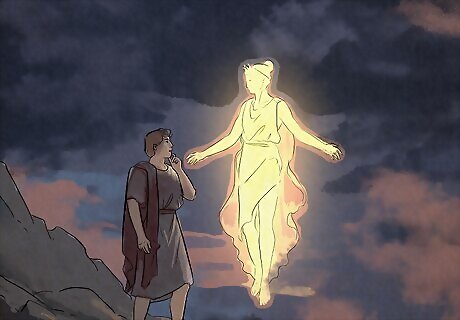
Daemon In ancient Greek mythology, daemons were lesser deities or guiding spirits of any kind. In one Greek tradition, daemons were like guardian spirits—existing with a person from the time of their birth throughout their lives. While typical daemons were supposed to be neutral spirits, there could be good or evil ones as well. For instance: Cacodemon - A type of evil spirit or demon, the opposite of an eudaemon. Eudaemon - A good attendant spirit, or, in some cases, a deified hero. Daemones Ceramici - Five malevolent spirits who tormented craftsmen and potters. They included Sýntrips (the smasher), Smáragos (the crasher), Ásbetos (the charrer), Sabáktes (the destroyer), and Omódamos (crudebake). Mormo - A vampiric spirit believed to prey on children; they were also attendants of the goddess of magic, Hecate.
Dryad A dryad is an oak tree nymph (or spirit) in Greek mythology. Nymphs, as a whole, are essentially personifications of nature, usually attached to a specific type of landform, tree, or place. They’re often depicted as feminine. While the most commonly-known tree nymph is probably the dryad, there are others as well—including the daphnaie (laurel tree nymph), the epimelides (fruit tree nymph), and meliae (ash tree nymph).
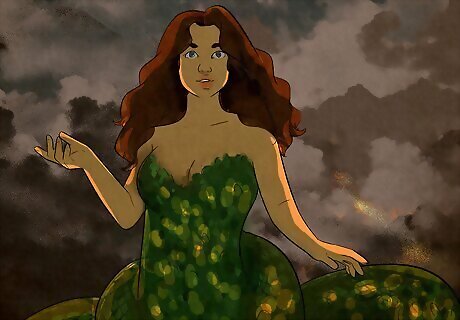
Echidna In Greek mythology, Echidna isn’t a type of creature, but a singular, monstrous woman—half-human and half-snake (with the top half of a human woman’s body and the rest of her body being serpentine). Echidna was the mate of Typhon, another feared monster in Greek myth; her parentage varies by myth, though she may be the daughter of Phorcys (a sea god), Chrysaor (a son of Poseidon and Medusa), or Styx (goddess of the river Styx).
Eidolon An eidolon is a sort of ghost or spirit-image in ancient Greek literature—it appears as a shade or phantom of a person (either living or dead). For instance, the Greek author Homer uses eidola in the Odyssey; after Penelope’s suitors are all killed, Theoclymenus (a prophet who foresees Odysseus’s return) says that he can see them filling up the doorway of the court.
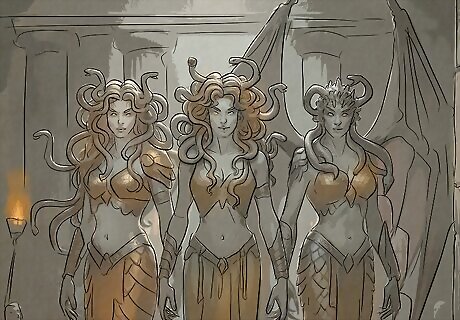
Gorgons You’ve probably heard of the infamous Medusa, but she’s just one of the three Greek gorgons—a trio of monstrous female sisters with snakes growing from their heads in place of hair. The gorgons are sometimes also depicted with other monstrous features, such as wings, tusks, or claws. The three gorgons are: Euryale - A gorgon capable of killing humans with her scream. Medusa - A gorgon whose gaze could turn creatures to stone. Stheno - A third gorgon sister who, like Euryale, was immortal.
Griffin The griffin—or gryphon—is a creature with the body, tail, and back legs of a lion, an eagle head and wings, and eagle-like talons on its front legs. Greek and Roman writings describe the griffin as having sharp beaks and typically being guardians of treasures or precious possessions. There are many iterations of the griffin throughout various mythologies, including tales from ancient Mesopotamia, Persia, and Egypt.
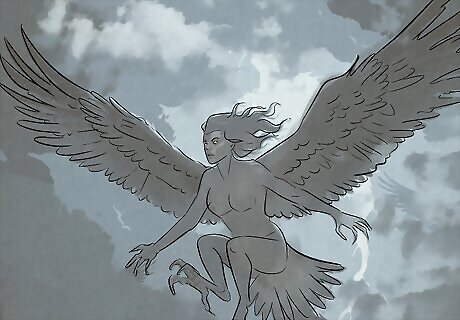
Harpies Harpies are creatures featured in Greek and Roman mythology as half-human, half-bird creatures, sometimes also depicted as a personification of storm winds. They usually appear as birds with female-looking heads and faces, wings, and clawed hands. In some traditions, they’re said to be hideous creatures—but other stories describe them as beautiful, winged maidens. Harpies were sometimes called the “hounds of mighty Zeus” or compared with the Erinyes (birdlike goddesses of vengeance). In some stories, harpies steal food and carry evil people away to the Erinyes. It was even said that when a person suddenly disappeared, they’d been snatched by harpies!
Hippocampus No, we’re not talking about the structure in your brain that makes new memories; in Greek mythology, the hippocampus is a creature with the upper body of a horse and the lower body of a fish. Its name even derives from the ancient Greek terms for “horse” and “sea monster.” Poseidon, the Greek god of the oceans, was sometimes depicted riding a sea-chariot drawn by hippocampi! Hippocampi aren’t exclusive to ancient Greek mythology, although the name is definitely Greek in origin; they also feature in Etruscan, Phoenician, Pictish, and Roman mythologies.
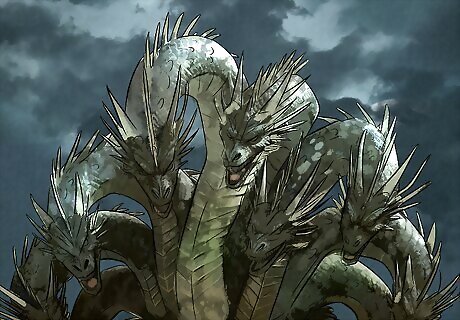
Hydra Specifically, we’re talking about the Lernaean Hydra—child of Typhon and Echidna, sibling to Cerberus and the chimera, and a deadly, many-headed serpentine lake monster with poisonous breath and blood. Early portrayals of the hydra give it six heads, then nine—and later, as many as fifty. Writers like Euripides and Virgil didn’t specify the number of heads, but did say that for each head severed, a pair would grow back. Heracles slays the Lernaean Hydra as his second labor, traveling to the monster’s home in the swamp near Lake Lerna.
Keres Keres were female death-spirits in Greek mythology, said to be lured by bloody deaths on battlefields. They couldn’t kill people; they simply waited until they could feast on the deceased, and were also considered personifications of violent death. The Keres were children of the goddess of night, Nyx; this also made them siblings of the Moirai (the three fates) and Thanatos (god of peaceful death).
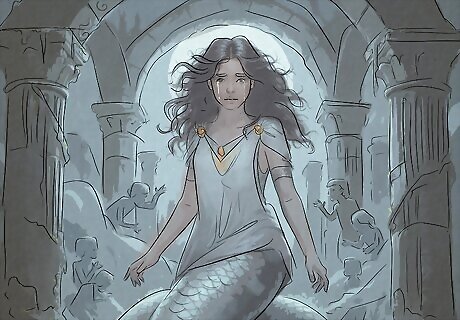
Lamia The original Lamia was singular—a queen of Libya who had an affair with Zeus, provoking Hera’s wrath. Hera took Lamia’s children from her, which drove Lamia insane, and she began to devour other people’s children, which transformed her into a monster. Later, the concept of lamia (or lamiai) evolved into a type of evil, haunting spirit (daemon), which also devoured children. Centuries ago, Greeks talked about the Lamia like a sort of bogeyman to get kids to behave.
Manticore The manticore is another hybrid monster from Persian and Greek mythology; it’s depicted with the body of a lion, a scorpion’s tail, and a humanoid face (although sometimes, the tail is covered in venomous spines instead that can shoot outward at will). In some myths, the manticore had three rows of sharp teeth in its human mouth and leathery wings like those of a bat or dragon.
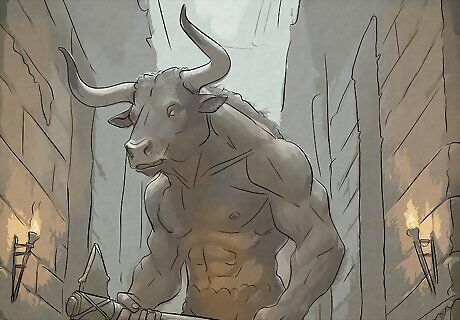
Minotaur One of the most famous examples of creatures from Greek mythology, the minotaur is part-man, part-bull—it has the head and tail of a bull, and the body of a man. In Greek myths, the minotaur lives in the center of the massive Labyrinth, an underground maze designed by the architect Daedalus for King Minos of Crete. The Minotaur is eventually slain by Theseus, an Athenian hero. Theseus is able to reach the center of the Labyrinth using a thread, given to him by the king’s daughter Ariadne. Before Theseus slays the minotaur, the kingdom’s tradition is to send fourteen young citizens into the Labyrinth every nine years as sacrifices for the Minotaur.
Nymph As mentioned above, a nymph is a type of nature spirit or deity in Greek mythology, intended to be a personification of nature. There are a lot of different types of nymphs (including dryads), each representing a different aspect of nature—from oceans and streams to mountains, trees, rain, and even times of day. These nymphs include: Alseids - Grove nymphs (tied to groves of trees) Hesperides - Evening nymphs, representing the golden light of sunsets Hyades - Rain nymphs, part of a sisterhood that summons or embodies rain Naiads - Spring nymphs, tied to fountains, wells, and natural springs or streams of water Nereids - Sea nymphs, often accompanying Poseidon and helpful to sailors Oceanids - Ocean nymphs, daughters of the Titan gods Oceanus and Tethys Oreads - Mountain nymphs, believed to accompany nature gods like Pan or Artemis Pleiades - Seven sister-nymphs who were companions to Artemis, goddess of the hunt
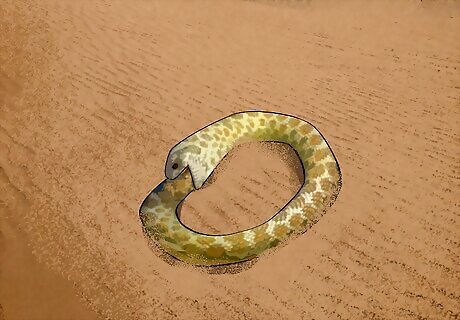
Ouroboros The ouroboros is a well-known motif that features in a few different ancient traditions, though its earliest iterations come from ancient Egyptian iconography as well as ancient Greece. As a symbol, the ouroboros depicts a snake (or dragon) eating its own tail, representing a cycle of eternal renewal—or, alternatively, the endless cycle of life, death, and rebirth.
Pegasus In Greek mythology, Pegasus is a winged horse—often depicted as a white stallion. In the legend of Perseus, Pegasus was sired by Poseidon and born from Medusa’s blood after Perseus cut off the gorgon’s head. Pegasus also allowed the Greek hero Bellerophon to ride him during his quest to defeat the Chimera, though Bellerophon later fell off Pegasus’s back and perished while trying to reach Mount Olympus. In other stories, Zeus himself (the leader of the Greek gods) brings Pegasus to Mount Olympus to carry Zeus’s thunderbolts.
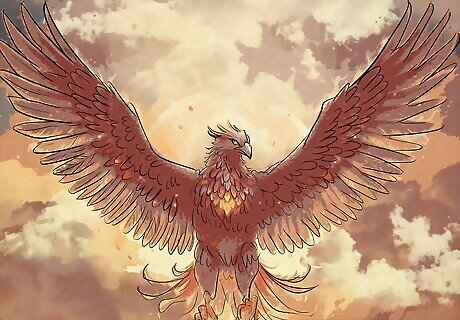
Phoenix The phoenix is another of the more iconic magical creatures in Greek mythology—a fiery, immortal bird that is continually reborn from the ashes of its predecessor. It “dies” in a whirl of flames, only to rise again! Over time, the phoenix has become a widely recognized symbol of time, renewal, fire, and the sun.
Satyr Greek satyrs are nature spirits that appear to be part-human, part-bestial—often with a humanoid head, arms, and torso, but goatlike or horselike legs. In legends, they’re depicted as being quite hedonistic, always drinking wine, playing music, dancing, and seeking out carnal pleasure. Fittingly, they were also said to be companions of Dionysus, the Greek god of wine and festivity.
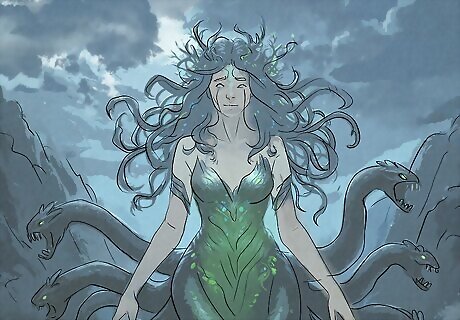
Scylla Scylla is a man-eating sea monster, once said to be a nereid—a beautiful sea nymph. After being transformed into her monstrous form, Scylla took up residence on one side of the narrow Strait of Messina, with the equally terrifying monster Charybdis living on the other side. Scylla was said to be a tentacled monster with many heads who would snatch passing sailors off their ships and eat them. As mentioned above, Scylla is first depicted in the Odyssey—the legend of Odysseus, wherein he and his crew must navigate Scylla and Charybdis’ strait.
Sirens Sirens are feminine, birdlike creatures that appear in Homer’s Odyssey. They’re often depicted as birds with beautiful human heads, or creatures with human upper bodies, bird legs, and wings. Regardless, sirens were said to have hauntingly beautiful voices capable of luring men to their deaths, and in the Odyssey, Odysseus ends up saving his crew from drowning and death at the hands of the sirens.
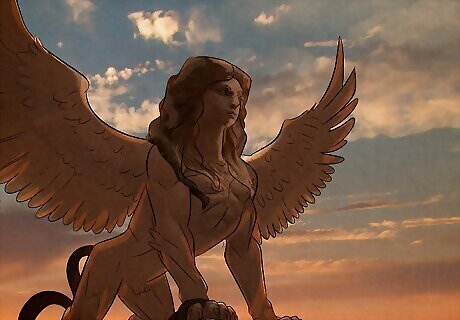
Sphinx The sphinx is another example of a creature that appears in multiple ancient traditions, and is often better-recognized in Egyptian mythology. However, Greek tradition depicts sphinxes as tricky, treacherous creatures with female heads, lion bodies, and birdlike wings. Greek legends say that the sphinx will pose a riddle to any who encounters her, and devour them if they fail to solve it. By comparison, Egyptian sphinxes typically have male heads and lion bodies without wings.
Typhon Typhon is said to be one of the deadliest and most terrifying creatures in Greek mythology…so it’s a good thing he’s a thing of fiction! Typhon is depicted as a ferocious serpentine giant with snakelike coils in place of limbs—or, according to the Greek poet Hesiod, a gigantic being with one hundred snake heads protruding from his shoulders and mouths that could all breathe fire. Legends paint Typhon as a bitter nemesis of Zeus who challenged him for control of the cosmos. Zeus and Typhon fought, with Zeus eventually winning and casting Typhon into Tartarus. Typhon’s parentage is debated; some myths say that he’s the child of Hera alone (who was angry at Zeus for giving birth to Athena by himself). In other myths, Typhon is the child of Gaia (the personification of Earth) and Tartarus (the personification of the dark underworld abyss where souls are judged).
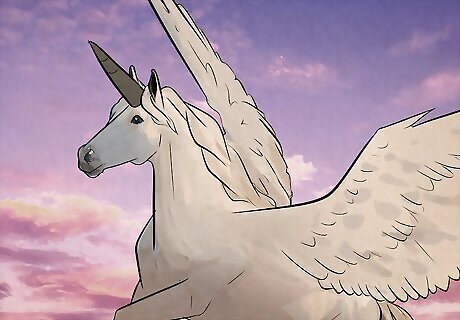
Unicorns Unicorns don’t actually appear in Greek mythology, but Greek writers believed they existed and wrote about them as though they were real creatures native to other lands, particularly India. The Greek historian Ctesias wrote a book called Indica (“On India”), and described unicorns as swift, horse-like creatures with pointed horns on their heads that could be colored white, red, and black. The more common depiction of unicorns as white horses with graceful, spiraling horns comes from European literature and art, especially from the Middle Ages and the Renaissance period. Do you feel like you’ve brushed up on your Greek mythology? Take our Greek mythology trivia quiz to test your knowledge!
Giants in Greek Mythology
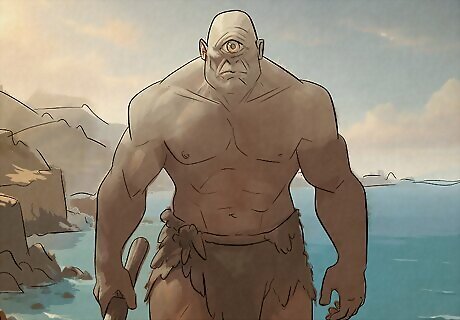
Cyclopes The cyclops (cyclopes) is another of the more iconic creatures from Greek mythology. They were said to be a tribe of one-eyed giants dwelling on the island of Sicily; while they herded sheep, they would also eat humans if given the chance. One such cyclops, Polyphemus, was a son of Poseidon who captured Odysseus and his men in the Odyssey, though Odysseus blinded him and escaped. There was also a pair of three cyclops siblings, Arges, Brontes, and Steropes, who were said to be the children of Gaia and Uranus and forged Zeus’s lightning bolts.
Gigantes The Gigantes were a race of powerful giants born when Uranus, personification of the sky, was castrated by Cronus, king of the Titans (and Uranus’ son), according to Greek poet Hesiod. Their claim to fame is the Gigantomachy (or Gigantomachia), a great battle fought against the Olympian gods. However, this sometimes led the Gigantes to be confused with Titans or other races believed to have battled the Olympians. Alcyoneus was said to be the greatest of the Gigantes, eventually killed by Heracles. Asterius was a giant killed by Athena. Enceladus was another giant who battled Athena in the Gigantomachy. Eurytus was a giant and the son of Gaia, killed by Dionysus in the Gigantomachy. Porphyrion was a kind of the giants (Gigantes).
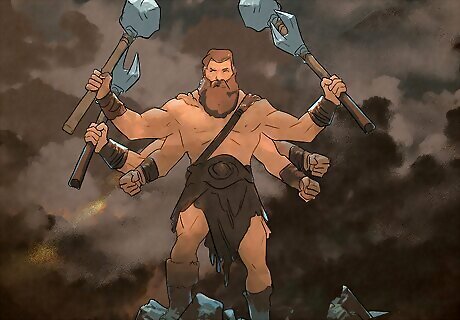
The Gegenees As described in the Greek epic Argonautica, the Gegenees were six-armed giants who lived on an island, and battled the Argonauts when they arrived there. The Argonauts mistakenly left Heracles on the island, where he kept fighting the Gegenees for a time (before the Argonauts returned to help Heracles finish his battle).
The Hecatoncheires The Hecatoncheires, also called the “Hundred-Handers,” were a trio of giant gods—each possessing a whopping fifty heads and one hundred arms! They were said to be the offspring of Gaia and Uranus, the gods of Earth and sky, respectively. In Greek myth, the Hecatoncheires sided with Zeus and the other Olympian gods, helping them overthrow the Titans. The three Hecatoncheires were: Briareus the Vigorous, Cottus the Furious, and Gyges the Big-Limbed.
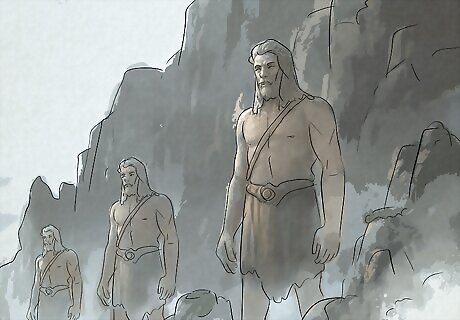
The Laestrygonians The Greek hero Odysseus encountered more than his share of giants during his travels! Not only did he run afoul of the cyclops, but he also encountered the Laestrygonians: a tribe of man-eating giants believed to have been spawned from Laestrygon (a son of Poseidon). In the Odyssey, the Laestrygonians devour many of Odysseus’s men and destroy most of his twelve ships, with only Odysseus’s own ship escaping unharmed.
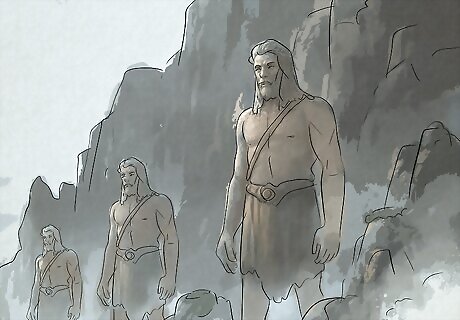
Other named giants Greek mythology contains references to numerous giants, many not part of a specific legendary race. Rather, these giants are more singular—often the children of gods or other powerful entities. For instance, some of the more prominent giants in Greek mythology include: Almops - A giant son of Poseidon and Helle (a half-nymph). Antaeus - A giant in Libya who wrestled everyone he encountered to death until Heracles killed him. Argus Panoptes - A giant with one hundred eyes who guarded Io, one of Zeus’s mortal lovers. Caucus - A fire-breathing giant killed in battle by Heracles. Geryon - A giant with one body and three heads (or, in other traditions, three bodies and six hands and feet). Orion - A giant huntsman made into the constellation of Orion by Zeus. Talos - A giant created by Hephaestus (forged from bronze), who served as Europa’s personal guard. Tityos - A giant killed by Apollo and Artemis for attacking their mother.
Dragons in Greek Mythology
Drakons Drakons—or dracones—were huge, serpentine creatures, sometimes with multiple heads. Contrary to Western interpretations of dragons, the drakon didn’t typically have wings and were basically just enormous serpents. They also didn’t usually breathe fire; more often, drakons are depicted as being able to spit poison. One such creature, the Laconian Drakon, was said to be the most terrible of all drakons. Greek myths describe drakon as guardians of sacred springs or treasure. The Greek term “drakein” translates to “to see clearly” or “gaze sharply.”
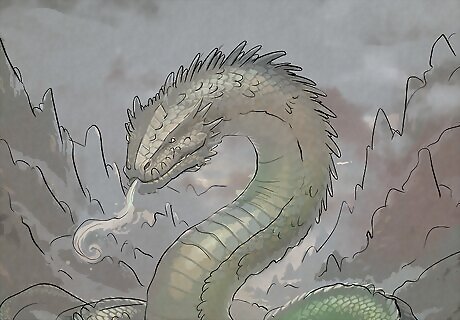
Cetea The Cetea were mythical Greek sea monsters—one such being Cetus, the monster covered above that nearly devoured Andromeda before being slain by Perseus. Other Cetea include the Trojan Cetus, a sea monster that terrorized Troy and was eventually killed by Heracles, as well as the Cetea at Taprobana—sea monsters believed to torment the area where modern-day Sri Lanka is located. “Cetus” is also the Greek word for “whale.” In addition to the above, there’s the Indian Cetea (sea monsters believed to dwell in the depths of the Indian Ocean) and the Scolopendra (a huge sea monster with rows of webbed feet and a tail resembling that of a crayfish).
Dracaenae The Dracaenae (or “She-Dragon”) were creatures believed to have the upper body of a beautiful maiden or nymph, and the lower body of a dragon or sea monster. Echidna—described above as Typhon’s mate and the mother to many famous Greek monsters—was one such famous Dracaenae, but there were many others! They include: Ceto - A primordial sea goddess and the mother of Echidna (as well as the Gorgons). Kampê - A dracaena tasked with guarding the gates of Tartarus by the Titan god Cronus. Poena - A dracaena sent to raze the kingdom of Argos by an angered Apollo as punishment for his son’s death. Scylla - A dracaena transformed into a many-headed sea monster that lived in a narrow strait, feeding on sailors alongside Charybdis. Sybaris - A dracaena believed to live in the mountains near Delphi, preying on travelers. The Scythian Dracaena - Said to be the dracaena queen of Scythia. She once stole Geryon’s cattle from Heracles and demanded he mate with her in exchange for their return.
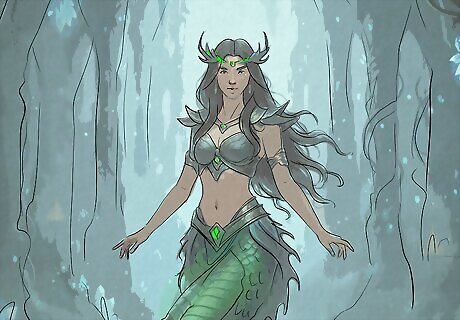
Other named dragonsLike the giants, Greek mythology contains references to other dragons beyond the drakons, Cetea, and dracaenae. These dragons often appear as servants of the gods, or else as menacing creatures that dwell around Greece, terrorizing nearby cities and kingdoms. Some of the more famous Greek dragons include: The Colchian Dragon - A dragon that did not sleep and guarded the Golden Fleece. Cychreides - A dragon that preyed on the island of Salamis before it was defeated (killed or tamed) by Cychreus. Demeter’s dragons - A pair of winged dragons that pulled Demeter’s (the goddess of harvest’s) chariot. The Gigantomachian dragon - A dragon thrown at Athena during the Olympian war with giants; she turned it into the constellation Draco. The Ismenian dragon - A dragon tasked with guarding the sacred spring of Ares (located near Thebes). Ladon - A dragon resembling a serpent that guarded the Hesperides’ golden apples of immortality. Medea’s dragons - A pair of winged dragons that pulled the sorceress Medea’s chariot. The Nemean dragon - A dragon tasked with guarding Zeus’s sacred grove in Nemea. The Ophiogenean dragon - A dragon sent to guard Artemis’s sacred grove in Mysia. Python - A dragon that guarded the oracle of Delphi. The Thespian dragon - A dragon that attacked the Boeotian city, Thespiae.



















Comments
0 comment